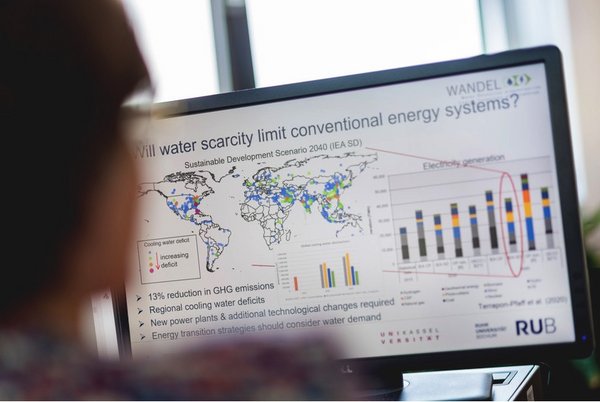- Share this article
- Subscribe to our newsletter
This is why freshwater must be considered in energy transition
Hydropower, biomass power generation, wind power, hydrogen and photovoltaics are terms which quickly come to mind when talking about the energy mix of the future – an energy mix that is supposed to combat climate change by limiting CO2 emissions. “But thinking in this way is too one-dimensional,” says Dr Martina Flörke, Professor of Engineering Hydrology and Water Resources Management at the Ruhr University Bochum (RUB)/Germany.
The researcher provides an example. “Photovoltaic plants or solar power plants are obviously located where there is a lot of sun, which is usually in the dry regions of the world,” Flörke says. “But solar power plants are also often cooled with water, and their mirrors have to be regularly cleaned of sand – with water.”
And yet, when planning for energy transition, water demand is often only considered for the location, while other water users and future developments are not factored in. However, the development of water supply and demand is crucial for the energy transition. Water can become a limiting factor for all sectors, and power plants that have not yet reached a critical level of use may be affected by water shortages in the future.
This aspect was the focus of the research project “WANDEL – Water Resources as Important Factors of the Energy Transition at the Local and Global Level”, which was officially wrapped up at the end of 2020 and coordinated by Martina Flörke, first at the University of Kassel/Germany and then at RUB. The project partners calculated the impact of different forms of energy generation on water resources and revealed a dilemma. The quest for affordable and clean energy and for sufficient supply of good-quality water – two of the UN’s 17 Sustainable Development Goals – are at odds with each other.
Conflicting sustainability goals
The conflict between the water and energy goals can be seen, for example, in a concentrated solar power plant in Morocco that was assessed in the WANDEL project. It is situated in a sunny location and promises to produce around 370 million kilowatt hours of electricity per year. However, since it is partly cooled with water and its mirrors also have to be cleaned at regular intervals, it consumes five litres of water per kilowatt hour of electricity produced. Thus the power plant would need two million cubic metres of water a year.
Model simulates global supply
Within the WANDEL project, the researcher and her team used a model that calculates water supply and demand worldwide. The model, called “WaterGAP3”, divides the Earth’s land mass into 2.2 million grid cells and thus has a geographical resolution of five arc minutes. At the equator, this translates into a cell size of nine by nine square kilometres. For each land cell, the researchers fed physiographic and meteorological data into the model, such as land cover, soil types, daily precipitation, temperature and solar radiation. Based on this data, the algorithm simulates the terrestrial water cycle: how much precipitation in each cell infiltrates into the soil or evaporates, and how much contributes to runoff generation and is then available as direct and groundwater runoff in rivers and aquifers. The simulation allows us to look back to pre-industrial times and make forecasts up to the year 2300.
The team calculated the water availability world-wide, taking into account only renewable freshwater resources, i.e. no fossil deep groundwater reserves. They then contrasted the water supply with the intended water extraction. To this end, they also included 48,000 locations of energy production plants and their water withdrawals and consumption.
Calculating water requirements for energy production
In order to make a forecast for the year 2040, the researchers relied on four future scenarios that Greenpeace and the International Energy Agency had drawn up. Presented in 2014/15, these scenarios outline how the energy mix could develop in the future.
The researchers reproduced this energy mix created by the four scenarios in their model. In the process, they assumed that in the future, more electricity would be generated using this method at locations which, for example, already produce energy using photovoltaics today. “We can’t know, of course, at which sites more photovoltaic plants will be built in the future, so in our model we can only work with the sites that currently exist – even though this is certainly a weak point, because production will also take place at other sites going forward,” explains Martina Flörke.
However, this doesn’t affect the key points of the calculations: a deficit is to be expected at up to 42 per cent of the locations, because more water will be needed there in the future than is available. “And this doesn’t even take into account the fact that the water demand in these regions could also increase for other reasons, for example because fields have to be more frequently irrigated due to the effects of climate change,” adds the researcher.
A full report will be published in the science journal Rubin.
(rub/wi)
Read more at RUB website





Add a comment
Be the First to Comment